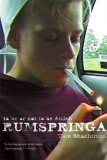Summary | Excerpt | Reviews | Beyond the Book | Readalikes | Genres & Themes | Author Bio

To Be or Not to Be Amish
by Tom Shachtman
In the cars once again, cell phones—also forbidden equipment—emerge from hiding places, some from under the girls’ clothing. Calls to compatriots in other vehicles, buggies as well as cars, yield the information that many dozens of Amish teenagers are now roaming the roads while trying to ascertain the location of this week’s “hoedown.” Soon it is identified: closer to Emma, a town three miles south of Shipshewana and not far from West-view High, the public school attended by many of the non-Amish revelers. The cars pass a young woman in a buggy heading in the direction of the party; she is smoking a cigarette and talking on her cell phone; the buggy’s window flaps are open, to disperse the tobacco smoke and perhaps to facilitate the cell phone connection.
As they would in similar settings in Holmes or Lancaster County, the young Amish on the road to a party in northern Indiana pass familiar territory composed of quiet Amish homesteads and farms, suburban-looking English homes, a few factories and assembly buildings, and some small workshops. Here is a roadside stand operated by a Yoder family; there is a quilt boutique run by a Miller family; the small-engine repair shop of a member of the Esh family is nestled on a side road but has a sign visible from the main route; over yonder is a Weaver family furniture-making factory.
Around midnight, scores of Amish teenagers and twentysome-things converge on the back acres of a farm south of Shipshewana, several miles from the nearest town, a third of a mile from the farmhouse, and hidden from the nearest road by a forest of cornstalks. A used-car-lot inventory of cars, trucks, buggies, bicycles, and motorcycles is already parked here. Iced coolers of beer are put out; Amish teenagers reach for bottles with both hands. Young, mechanically adept men hook up portable CD players and boom-box speakers to car batteries. Shortly, rock and rap music blasts. Heads nod and bodies sway to the beat.
Many of the Amish kids know the words of the most current rock songs, even of black rap recordings that speak of mayhem in inner-city ghettos and anger against whites, songs they have learned from listening to battery-powered radios that they bought with the first money they earned, and that they have kept hidden at home. “When I’m angry at my bossy brothers,” one young lady says, “I play rock on my radio; when I’m happy, I play country.”
To have a focus for the party, the participants gather straw and brush for a bonfire. Its bright light and stark shadows crosshatch partygoers at the edges of the center, where various transactions are occurring. Most of the Amish youth are from northern Indiana, but some have come from across the state line in Michigan or from many hours away in Missouri and Ohio. There are about four hundred youth at this almost-deserted site, out of about two thousand adolescent Amish in northern Indiana. Some of the kids are what others refer to as “simmies,” literally, foolish in the head, young, naïve, new to rumspringa—and, most of them, willing to work hard to lose the label quickly.
Beer is the liquid of choice, but there are also bottles of rum and vodka, used to spike soft drinks. Some of the younger kids do not know the potency of what they are drinking, or what it might do to them. Many will be sick before long. Most guzzle to mimic the others, while gossiping about who is not there or is not drinking. This night, one young woman will wonder why she always seems to drink too much.
In one corner of the party, joints of marijuana are passed around, as are pipes of crank (crystal methamphetamine). Lines of cocaine are exchanged for money. A handful of the partygoers are seriously addicted, while others are trying drugs for the first time. Crank is incredibly and instantly addictive, and it is relatively simple and cheap to make; the only ingredient used that is not available from a local hardware store, anhydrous ammonia, is a gaseous fertilizer easily stolen from tanks on farms. Those few partygoers interested in doing hard drugs gather in a different location than the majority, who prefer drinking beer or smoking pot.
Excerpted from Rumspringa by Tom Shachtman. Copyright © 2006 by Tom Shachtman. Published in June 2006 by Farrar, Straus and Giroux, LLC. All rights reserved.






Your guide toexceptional books
BookBrowse seeks out and recommends the best in contemporary fiction and nonfiction—books that not only engage and entertain but also deepen our understanding of ourselves and the world around us.